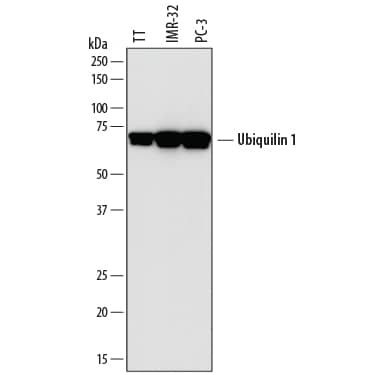Human Ubiquilin 1 Antibody
R&D Systems, part of Bio-Techne | Catalog # AF7969

Key Product Details
Species Reactivity
Applications
Label
Antibody Source
Product Specifications
Immunogen
Arg546-Gly585
Accession # Q9UMX0
Specificity
Clonality
Host
Isotype
Scientific Data Images for Human Ubiquilin 1 Antibody
Detection of Human Ubiquilin 1 by Western Blot.
Western blot shows lysates of TT human medullary thyroid cancer cell line, IMR-32 human neuroblastoma cell line, and PC-3 human prostate cancer cell line. PVDF membrane was probed with 2 µg/mL of Sheep Anti-Human Ubiquilin 1 Antigen Affinity-purified Polyclonal Antibody (Catalog # AF7969) followed by HRP-conjugated Anti-Sheep IgG Secondary Antibody (Catalog # HAF016). A specific band was detected for Ubiquilin 1 at approximately 65-70 kDa (as indicated). This experiment was conducted under reducing conditions and using Immunoblot Buffer Group 1.Applications for Human Ubiquilin 1 Antibody
Western Blot
Sample: TT human medullary thyroid cancer cell line, IMR‑32 human neuroblastoma cell line, and PC‑3 human prostate cancer cell line
Formulation, Preparation, and Storage
Purification
Reconstitution
Formulation
Shipping
Stability & Storage
- 12 months from date of receipt, -20 to -70 °C as supplied.
- 1 month, 2 to 8 °C under sterile conditions after reconstitution.
- 6 months, -20 to -70 °C under sterile conditions after reconstitution.
Background: Ubiquilin 1
Ubiquilin-1 (also known as DA41 and PLIC-1/Protein Linking IAP with Cytoskeleton 1) is a 62-70 kDa intracellular member of the UBL-UBA family of proteins. Consistent with its name, it ubiquitously expressed, and is particularly prominent in skeletal muscle and neurons. Multiple functions have been attributed to ubiquilin-1. For instance, it is now known to be a key player in APP processing. On the cleavage side, ubiquilin-1 binds to PS/presenilin, a component of the gamma-secretase complex that cleaves APP. Ubiquilin-1 appears to target both ubiquitinated single chain PS to the proteosome, and aggregated PS to the aggresome. With respect to APP, ubiquilin-1 serves as a molecular chaperone, binding to and inhibiting APP aggregation. On cells expressing CD47, Ubiquilin-1 acts as an intermediary between integrins, the cytoskeleton and CD47, promoting cell spreading. And in neurons, ubiquilin-1 stabilizes both membrane and GABA subunit stability, enhancing inhibitory synaptic transmission. Human ubiquilin-1 is 589 amino acids (aa) in length. It contains one ubiquitin-like domain (aa 37-111), an S5a binding site (aa 72-105) and a UBA binding region (aa 548-585). There are multiple splice variants, ranging from 19-59 kDa in size. One shows a deletion of aa 418-445, a second contains a three aa substitution for aa 151-589, a third possesses a 29 aa substitution for aa 112-589, and a fourth shows a deletion of aa 61-237 coupled to a second deletion of aa 361‑589. Over aa 546-585, human and mouse ubiquilin-1 are identical in amino acid sequence.
Alternate Names
Gene Symbol
UniProt
Additional Ubiquilin 1 Products
Product Documents for Human Ubiquilin 1 Antibody
Product Specific Notices for Human Ubiquilin 1 Antibody
For research use only
